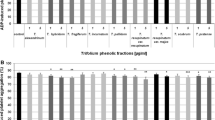Abstract
Inhibition of human platelet aggregation by eight chlorophenoxyacid herbicides was studied in vitro. Thrombocyte aggregation in the platelet-rich plasma was induced by 1.0–32.0 μM adenosine diphosphate (ADP), 0.32–32.0 μM adrenaline or 7.5–30.0 μg/ml collagen with and without chlorophenoxyacid (0.05–2.0 mg/ml). Platelet aggregation by each inducer was inhibited dose dependently by all the eight chlorophenoxyacids at concentrations between 0.1 and 2.0 mg/ml. Increasing the concentrations of ADP and collagen but not of adrenaline inhibited the antiaggregatory action of chlorophenoxy-acids. No essential differences in inhibitory effect were found between different chlorophenoxyacids varying in respect of their ring substituents and the length of the carboxylic side chain. In the platelet-rich plasma prepared from rabbits 2.5 h after subcutaneous injection of 2,4-dichlorophenoxyacetic acid or 4-chloro-2-methylphenoxy-acetic acid (100–150 mg/kg), platelet aggregation by ADP was inhibited 20–30%, compared to plasma taken from the rabbits before the chlorophenoxyacid treatment. The inhibition had disappeared by 20–23 h after administration. The results indicate that chlorophenoxyacid herbicides inhibit human platelet aggregation. Furthermore, the inhibition is probably involved in haemorrhages known to occur in various tissues of animals intoxicated by chlorophenoxyacid herbicides.
Similar content being viewed by others
References
Bucher NLR (1946) Effects of 2,4-dichlorophenoxyacetic acid on experimental animals. Proc Soc Exp Biol Med 63: 204–205
Charo IF, Feinman RD, Detwiler TC (1977) Interrelations of platelet aggregation and secretion. J Clin Invest 60: 866–873
Courtney KD (1970) 2,4,5-T in the rat: excretion pattern, serum levels, placental transport, and metabolism. In: Deichmann WB (ed) Pesticides symposia. Halos and Associates Inc, Miami, pp 277–283
Drill VA, Hiratzka T (1953) Toxicity of 2,4-dichlorophenoxyacetic acid and 2,4,5-trichlorophenoxyacetic acid. A report on their acute and chronic toxicity in dogs. Arch Ind Hyg Occup Med 7: 61–67
Elo HA, Ylitalo P (1979) Distribution of 2-methyl-4-chlorophenoxyacetic acid and 2,4-dichlorophenoxyacetic acid in male rats: evidence for the involvement of the central nervous system in their toxicity. Toxicol Appl Pharmacol 51: 439–446
Hill EV, Carlisle H (1947) Toxicity of 2,4-dichlorophenoxyacetic acid for experimental animals. J Ind Hyg Toxicol 29: 85–95
Hung SC, Ghali NJ, Venton DL, Le Breton GC (1983) Specific binding of the thromboxane A2 antagonist 13-azaprostanoid acid to human platelet membranes. Biochim Biophys Acta 728: 171–178
Kinlough-Rathbone RL, Packham MA, Reimers HJ, Cazenave JR, Mustard JF (1977) Mechanism of shape change, aggregation and release induced by collagen, thrombin or A 23 187. J Lab Clin Med 90: 707–719
Moncada S, Vane JR (1979) Pharmacology and endogenous roles of prostaglandin endoperoxides, thromboxane A2 and prostacyclin. Pharmacol Rev 30: 293–331
Nielsen K, Kampe B, Jensen-Holm J (1965) Fatal poisoning in man by 2,4-dichlorophenoxyacetic acid (2,4-D): determination of the agent in forensic materials. Acta Pharmacol Toxicol 22: 224–234
O'Reilly RA (1985) Anticoagulant, antithrombotic, and thrombolytic drugs. In: Goodman Gilman A, Goodman LS, Rall TW, Murad F (eds) Goodman and Gilman's The pharmacological basis of therapeutics, 7th ed. MacMillan Publishing Company, New York, pp 1338–1359
Osterloh J, Lotti M, Pond SM (1983) Toxicologic studies in a fatal overdose of 2,4-D, MCPP, and chlorpyrifos. J Anal Toxicol 7: 125–129
Patscheke H, Stegmeier K (1985) Effects of the prostaglandin H2/thromboxane A2 antagonist BM 13.177 on human platelets. Adv Prostaglandins Thromboxane Leukotriene Res 13: 371–373
Prescott LF, Park J, Darrien I (1979) Treatment of severe 2,4-D and mecoprop intoxication with alkaline diuresis. Br J Clin Pharmacol 7: 111–116
Rowe VK, Hymas TA (1954) Summary of toxicological information on 2,4-D and 2,4,5-T type herbicides and an evaluation of the hazards to livestock associated with their use. Am J Vet Res 15: 622–629
Stegmeier K, Pill J, Muller-Beckmann B, Schmidt FH, White EC, Wolff HP, Patscheke H (1984) The pharmacological profile of the thromboxane A2 antagonist BM 13.177. A new antiplatelet and antithrombotic drug. Thromb Res 35: 379–395
Author information
Authors and Affiliations
Rights and permissions
About this article
Cite this article
Elo, H.A., Luoma, T. & Ylitalo, P. Inhibition of human and rabbit platelet aggregation by chlorophenoxyacid herbicides. Arch Toxicol 65, 140–144 (1991). https://doi.org/10.1007/BF02034941
Received:
Accepted:
Issue Date:
DOI: https://doi.org/10.1007/BF02034941



